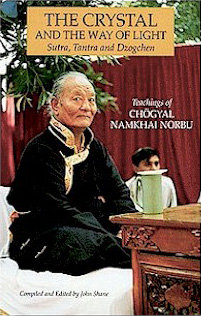What is Dzogchen?
 Excerpt from THE CRYSTAL AND THE WAY OF LIGHT by Chögyal Namkhai Norbu, edited by John Shane
Excerpt from THE CRYSTAL AND THE WAY OF LIGHT by Chögyal Namkhai Norbu, edited by John Shane
“Most people think that all religion is based on faith, which they regard as little better than superstition, with no relevance to the modern world. But Dzogchen shouldn’t be regarded as a religion, and it doesn’t ask anyone to believe in anything. On the contrary, it suggests that the individual observe him or herself and discover for themselve what their actual condition is.
“In Dzogchen teachings, the individual is regard as functioning at three independent levels, of body, voice or energy, and mind. Even someone who says they don’t believe in anything cannot say they don’t believe in their own body! It’s basic to their existence, and the limits and problems of the body are clearly tangible. We feel cold and hunger, we suffer pain and loneliness, and we spend much of our lives in an attempt to overcome our physical suffering…
“…To deal with these problems of body, voice, and mind, the Dzogchen teachings present practices that work with each of these three levels of the individual, practices that can be integrated with the individual’s daily life and which can thus change our whole life experience from one of tension and confusion to one of wisdom and true freedom. The teachings are not merely theoretical, they are practical; and though the Dzogchen teachings are extremely ancient, because the nature of the body, voice, and mind of the individual has not changed these teachings remain as relevant to the human situation of today as they were to that of yesterday.”
The Primordial State
“The teaching of Dzogchen is in essence a teaching concerning the primordial state that is each individual’s own intrinsic nature from the very beginning. To enter this state is to experience oneself as one is, as the center of the universe though not in the ordinary ego sense. …To discover this primordial state is to understand the teaching of Dzogchen, and the function of the transmission of the teaching of Dzogchen is to communicate this state from one who has realized, or become established in it, to those who remain caught up in the dualistic condition. Even the name Dzogchen, which means ‘Great Perfection’, refers to the self-perfectedness of this state, fundamentally pure from the beginning, with nothing to reject or accept.
“To understand and enter the primordial state one does not need intellectual, cultural, or historical knowledge. It is beyond intellect by its very nature. Yet when people encounter a teaching they have not heard of before, one of the first things they may want to know is where this teaching arose, where it came from, who taught it, and so on. This is understandable, but Dzogchen itself cannot be said to belong to the culture of any country… … Although it is true that the tradition of Dzogchen that we are about to consider has been transmitted through the culture of Tibet that has harbored it ever since the beginning of recorded history in Tibet, we nevertheless cannot finally say that Dzogchen is Tibetan, because the primordial state itself has no nationality and is omnipresent.
“…It’s not that the teachings of Dzogchen were ever particularly widespread of well-known in Tibet; in fact rather the reverse was true. Dzogchen was always a somewhat reserve teaching. But the Dzogchen teachings are the essence of all Tibetan teachings, so direct that they were always kept a little hidden, and people were often a little afraid of them. Furthermore, there existed a tradition of Dzogchen among the ancient Bön traditions, the indigenous and largely shamanic traditions of Tibet, that pre-date the arrival of Buddhism from India.
“Thus, if we consider the Dzogchen teachings as being the essence of all the Tibetan spiritual traditions, both Buddhist and Bön (though itself actually belonging to neither Buddhism nor Bön), and if we understand that the spiritual traditions of Tibet were the essence of Tibetan culture, then we can use the Dzogchen teachings as a key to the understanding of Tibetan culture as a whole. And with this perspective, it can be seen how all the various aspects of Tibetan culture have been manifested as facets of the unified version of realized beings, the masters of the spiritual traditions.
“Like a crystal at the heart of the culture, the clarity of the primordial state, as manifested in the minds of many masters, has radiated the forms of Tibetan art and iconography, medicine, and astrology, like brilliant rays, or sparkling reflections. So by coming to understand the nature of the crystal, we will be better able to make sense of the rays and reflections that emanate from it.”
—Chögyal Namkhai Norbu, edited by John Shane, THE CRYSTAL AND THE WAY OF LIGHT, pg. 31-34
To learn more about Dzogchen and Buddhism, please check out the reading list section!

